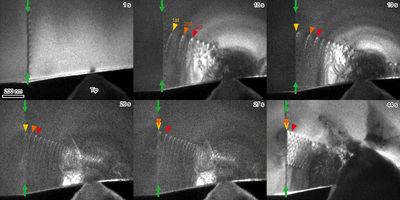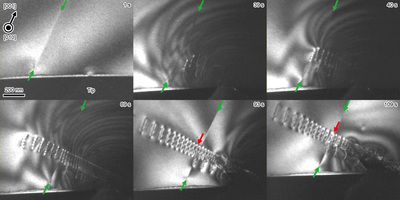Authors
Shun Kondo, Tasuku Mitsuma, Naoya Shibata, and Yuichi Ikuhara
Abstract
In deformation processes, the presence of grain boundaries has a crucial influence on dislocation behavior; these boundaries drastically change the mechanical properties of polycrystalline materials. It has been considered that grain boundaries act as effective barriers for dislocation glide, but the origin of this barrier-like behavior has been a matter of conjecture for many years. We directly observe how the motion of individual dislocations is impeded at well-defined high-angle and low-angle grain boundaries in SrTiO3, via in situ nanoindentation experiments inside a transmission electron microscope. Our in situ observations show that both the high-angle and low-angle grain boundaries impede dislocation glide across them and that the impediment of dislocation glide does not simply originate from the geometric effects; it arises as a result of the local structural stabilization effects at grain boundary cores as well, especially for low-angle grain boundaries. The present findings indicate that simultaneous consideration of both the geometric effects and the stabilization effects is necessary to quantitatively understand the dislocation impediment processes at grain boundaries.

Sequential TEM images captured from the movie of the nanoindentation experiment for the Σ5 grain boundary.
Sequential dark-field TEM images captured from the movie recorded during the nanoindentation experiment. The line contrasts indicated by the green arrows correspond to the Σ5 grain boundary. The positions of the leading three lattice dislocations are indicated by the triangles. The indenter tip was gradually inserted from 0 to 42 s, and the specimen edge was fractured at 43 s. The dislocation motion was strongly impeded by the grain boundary, which resulted in the dislocation pileup. In this experiment, the first and second dislocations and the lower part of the third dislocation were trapped on the grain boundary plane even after the external stress was removed.

Sequential TEM images captured from the movie of the nanoindentation experiment for the low-angle tilt grain boundary.
Sequential dark-field TEM images captured from the movie recorded during the nanoindentation experiment. The green arrows in each image indicate the grain boundary position. In this experiment, the indenter tip was gradually inserted into the specimen edge from 0 to 85 s and extracted from 86 to 109 s. The introduced lattice dislocations propagated through the crystal and crossed the grain boundary into the adjacent crystal. In the unloading process, the lattice dislocations moved backward, and some dislocations crossed the grain boundary again and back into the initial crystal, where the grain boundary impeded the dislocation propagation. In the end, the dislocation indicated by the red arrow is impeded on the grain boundary plane.
Science Advances URL:http://advances.sciencemag.org/content/2/11/e1501926.full
You May Also Like
These Related Stories
